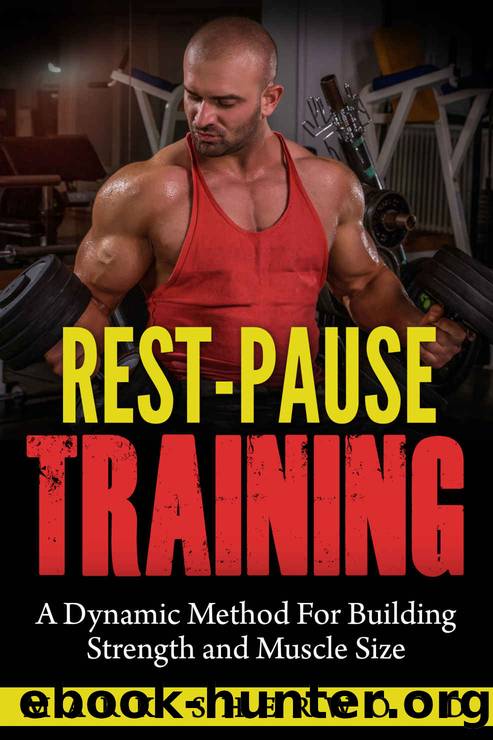Rest Pause Training: A Dynamic Method for Building Strength and Muscle Size by Mark Sherwood & Mark Sherwood

Author:Mark Sherwood & Mark Sherwood [Sherwood, Mark]
Language: eng
Format: mobi
Publisher: Mark Sherwood
Published: 2016-04-29T16:00:00+00:00
Chapter 8
How to Find Your Capacity for Strong Training
How do you push to the edge of your capacity for strong training without exceeding it? You can do so by understanding where the transition points occur between strong training and weak training. There are three points in training where these transition points occur. Each shall be listed with the first two transition points being explained in this chapter, and the third in the next chapter.
1. The transition between strong reps and weak reps.
2. The transition between a strong lifting motion and a weak lifting motion.
3. The transition between strong sets and weak sets.
The Transition between Strong Reps and Weak Reps
When doing consecutive reps, strong reps are based on the ability to maintain a steady even rep pace from one rep to the next within the same set. As fatigue accumulates toward the end of a set, a point will eventually come where a steady even rep pace can no longer be maintained and a transition to weak reps will occur. Weak reps are slower, less forceful reps that occur when pushing past the point of being able to maintain the ability to do strong reps using a steady rep pace. If you push to the point of a weak rep, stop immediately and rest fifteen seconds to start doing rest-pause reps.
Single Strong Reps vs. Single Weak Reps
If you are doing single rest-pause reps, you must be aware of how forcefully you can lift a rep when you are at full strength. When you feel the speed or power of your reps diminish while doing single rest- pause reps, you are no longer doing strong reps and have transitioned to weak reps. When doing power based rest-pause training with single reps, strong reps should be emphasized during workouts and you should stop an exercise if you transition to weak reps.
The Transition between a Strong Lifting Motion and a Weak Lifting Motion
When doing power based single reps, never train so heavy that you sacrifice form or a strong lifting motion. A strong lifting motion consists of a smooth nonstop lifting motion that is devoid of any pauses, hitches, or slowing down during the positive portion of the lift. If you exceed this capacity with excessively heavy weights, you will transition to a weak lifting motion. A weak lifting motion occurs when you start to do grinder reps. This simply means that some portion of the lifting motion is accompanied by pauses, jerking, or slowing down. Poor form often accompanies a weak lifting motion. Stick with a strong lifting motion, and avoid a weak lifting motion.
If you stay within the boundaries of strong reps and a strong lifting motion, you may find that you can use rest-pause training often without over training; especially if you limit the amount of sets you do to strong sets, which will be discussed in the next chapter.
Download
This site does not store any files on its server. We only index and link to content provided by other sites. Please contact the content providers to delete copyright contents if any and email us, we'll remove relevant links or contents immediately.
Ninja Strength Secrets: Isometric Exercise Routines for a Bruce Lee Body by Lee Driver(448)
Letters to a Young Athlete by Chris Bosh(400)
Mastering Self Defense : Ability 1 Hand and Eye Coordination by Sulayman Qi Sheng(390)
Training for the Uphill Athlete by Steve House & Scott Johnston & Kilian Jornet(379)
Coaching For Life by Paul Annacone(362)
Jose Silva Guide to Mental Training for Fitness and Sports: Think and Grow Fit by Jose Silva(332)
Solo Training: The Martial Artist's Guide to Training Alone by Christensen Loren W(328)
Complete Conditioning for Soccer by Ryan Alexander(297)
Messi â 2015 Updated Edition by Luca Caioli(289)
Unplugged by Brian Mackenzie Dr. Andy Galpin & Phil White(274)
Out of the Pocket by Kirk Herbstreit(269)
The Mushin Way to Peak Performance by Michael Veltri(266)
Rebound by Matt Doherty(263)
Pep Confidential: Inside Pep Guardiola's First Season at Bayern Munich by Martí Perarnau(259)
Ron Fawcett--Rock Athlete by Ron Fawcett(254)
Invincible Mind: The Sports Psychology Tricks You can use to Build an Unbeatable Body and Mind! (Mental Combat Book 2) by Phil Pierce(254)
Fantasy Football for Smart People: How to Dominate Your Draft by Jonathan Bales(242)
Mind Games: The Ups and Downs of Life and Football by Neville Southall(239)
Rest Pause Training: A Dynamic Method for Building Strength and Muscle Size by Mark Sherwood & Mark Sherwood(237)
